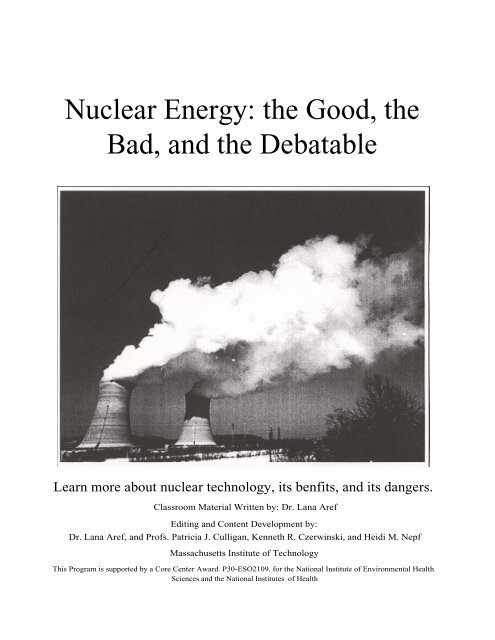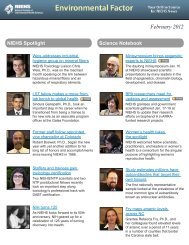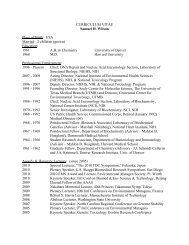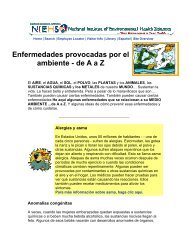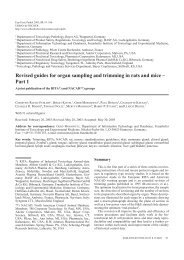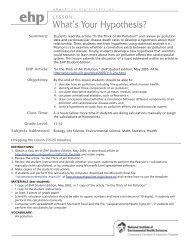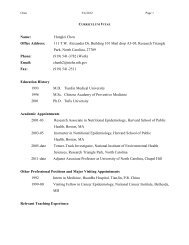Nuclear Energy: the Good, the Bad, and the Debatable - Curriculum ...
Nuclear Energy: the Good, the Bad, and the Debatable - Curriculum ...
Nuclear Energy: the Good, the Bad, and the Debatable - Curriculum ...
Create successful ePaper yourself
Turn your PDF publications into a flip-book with our unique Google optimized e-Paper software.
<strong>Nuclear</strong> <strong>Energy</strong>: <strong>the</strong> <strong>Good</strong>, <strong>the</strong><br />
<strong>Bad</strong>, <strong>and</strong> <strong>the</strong> <strong>Debatable</strong><br />
Learn more about nuclear technology, its benfits, <strong>and</strong> its dangers.<br />
Classroom Material Written by: Dr. Lana Aref<br />
Editing <strong>and</strong> Content Development by:<br />
Dr. Lana Aref, <strong>and</strong> Profs. Patricia J. Culligan, Kenneth R. Czerwinski, <strong>and</strong> Heidi M. Nepf<br />
Massachusetts Institute of Technology<br />
This Program is supported by a Core Center Award. P30-ESO2109. for <strong>the</strong> National Institute of Environmental Health<br />
Sciences <strong>and</strong> <strong>the</strong> National Institutes of Health
<strong>Nuclear</strong> <strong>Energy</strong>: The <strong>Good</strong>, The <strong>Bad</strong>, <strong>and</strong> The <strong>Debatable</strong>.<br />
How is <strong>Nuclear</strong> <strong>Energy</strong> Produced?<br />
<strong>Nuclear</strong> energy is produced when an atom's nucleus is split into smaller nuclei by <strong>the</strong> process<br />
called fission. The fission of large atoms, such as Uranium 235 <strong>and</strong> Plutonium 239, produces a<br />
great deal of energy. In fact, <strong>the</strong> fission of 1 gram of Uranium 235 produces <strong>the</strong> same amount of<br />
energy as <strong>the</strong> combustion, or burning, of 3 tons of coal (1)! The energy produced by <strong>the</strong> fission<br />
of uranium or plutonium can be harnessed to produce electricity, to propel space craft, <strong>and</strong> to<br />
power weapons like <strong>the</strong> Atomic Bomb.<br />
Unlike a traditional coal-burning power plant, a nuclear power plant uses <strong>the</strong> energy, or heat,<br />
produced by <strong>the</strong> fission of Uranium, ra<strong>the</strong>r than <strong>the</strong> burning of coal, to heat water into <strong>the</strong> steam<br />
required to turn <strong>the</strong> turbines that power electric generators. The advantage of using Uranium over<br />
coal energy is that, unlike for coal, Uranium fission does not produce soot <strong>and</strong> potentially<br />
harmful gases such as Carbon Dioxide. However, like coal, Uranium is mined <strong>and</strong> <strong>the</strong>n<br />
processed before it can be used as an energy source. Also, like coal, <strong>the</strong> different mining <strong>and</strong><br />
processing steps, as well as <strong>the</strong> actual energy production, produce a great deal of waste. Unlike<br />
coal, however, <strong>the</strong>se wastes are radioactive, <strong>and</strong> thus more difficult to h<strong>and</strong>le.<br />
What is radioactivity?<br />
A radioactive element is an element that is unstable, <strong>and</strong> which continually decays by releasing<br />
radiation. Radiation is made up of high-energy particles or rays that can penetrate <strong>and</strong> damage<br />
<strong>the</strong> matter with which it comes into contact. The sun, for example, also releases radiation, which,<br />
in large doses, can damage our skin.<br />
All elements that have an atomic number higher than 83, that is, all elements that have more than<br />
83 protons in <strong>the</strong>ir nucleus, are radioactive. This includes Uranium, which has an atomic number<br />
of 92. It, like o<strong>the</strong>r radioactive elements, is located everywhere in nature <strong>and</strong> can be found in<br />
rock formations all over <strong>the</strong> world.<br />
During <strong>the</strong> decay process, a radioactive element emits ei<strong>the</strong>r an alpha or beta particle, which are<br />
sometimes accompanied by a gamma ray. In doing so, it changes from its original unstable form<br />
into o<strong>the</strong>r elements, called daughter elements, which can also be radioactive. These radioactive<br />
daughter elements also undergo decay, until, ultimately, a stable element is formed. This chain<br />
of decay is called a radioactive decay series. There are three series: <strong>the</strong> uranium series, <strong>the</strong><br />
thorium series. <strong>and</strong> <strong>the</strong> actinium series. For example, <strong>the</strong> uranium series starts with Uranium<br />
238, which changes into at least 14 different elements before it stabilizes as Lead 206. This<br />
series is outlined in Table 1 (2).<br />
The length of time it takes for each element to decay depends on <strong>the</strong> type, as well as on <strong>the</strong><br />
amount of <strong>the</strong> radioactive element present. The half-life of a radioactive material is <strong>the</strong> length of<br />
time it takes for half of that material to decay. Some radioactive elements, like Lead 214, have a<br />
half-life of seconds, some like Radon 222 have a half-life of days. <strong>and</strong> some like Uranium 238<br />
Lana Aref © Massachusetts I nstitute of Technology� <strong>Nuclear</strong> <strong>Energy</strong>
��<br />
have a half-life of 4.5 billion years. As you see, it can take a long time for radioactive materials<br />
to stabilize.<br />
What are <strong>the</strong> different types of radiation?<br />
There are three major types of radiation. That is, <strong>the</strong>re are three forms of energy that are emitted<br />
by radioactive elements as <strong>the</strong>y decay. First, <strong>the</strong>re are alpha particles, which consist of 2 protons<br />
<strong>and</strong> 2 neutrons. These particles are highly energized, but because <strong>the</strong>y are so large, can not<br />
penetrate matter very deeply, <strong>and</strong> can be stopped by a single sheet of paper. However, if <strong>the</strong>se<br />
particles do manage to come into contact with unprotected, internal cells, by ingestion for<br />
example, <strong>the</strong>y can be extremely harmful. Second, <strong>the</strong>re are beta particles, which are <strong>the</strong> same as<br />
electrons. These are not as highly energized as alpha particles but can penetrate skin. Beta<br />
particles are also harmful when ingested, but since <strong>the</strong>y are smaller <strong>the</strong>y do not do as much<br />
internal damage. Third, <strong>the</strong>re are Gamma rays. These electromagnetic waves, or photons, are<br />
similar to X-rays <strong>and</strong> can penetrate <strong>the</strong> body <strong>and</strong> organs easily. Gamma rays, though not as<br />
powerful as alpha particles, are dangerous because <strong>the</strong>y are so invasive.<br />
To underst<strong>and</strong> <strong>the</strong> relative harm imparted by <strong>the</strong>se three types of radiation, consider <strong>the</strong><br />
following analogy. Let's say that alpha particles are <strong>the</strong> same as a really potent poison pill, beta<br />
particles are <strong>the</strong> same as an acid solution, <strong>and</strong> gamma rays are like a noxious gas. The poison<br />
pill isn't very harmful if you touch it, but can kill you if you swallow it. The acid solution would<br />
burn your skin if you touched it <strong>and</strong> is somewhat harmful if contacted in this manner. However,<br />
an acid solution would burn your insides if you drank it, <strong>and</strong> so is a lot more harmful if contacted<br />
in this way. In <strong>the</strong> case of <strong>the</strong> noxious gas, it permeates everywhere, since it is a gas, <strong>and</strong> even<br />
though it's not as deadly as <strong>the</strong> pill or <strong>the</strong> acid, you are more easily exposed to it. Of course, <strong>the</strong><br />
amount of poison in <strong>the</strong> pill, of <strong>the</strong> acid in <strong>the</strong> solution, or of <strong>the</strong> gas in <strong>the</strong> air, <strong>and</strong> <strong>the</strong> length of<br />
time you are exposed to <strong>the</strong>m affects how sick (or terminally ill) you become. This is also true<br />
for radiation.<br />
The <strong>Nuclear</strong> <strong>Energy</strong> Debate:<br />
The use of <strong>Nuclear</strong> Power has been controversial for a long time. Proponents of its use claim<br />
that it is a very 'clean' form of energy since very little fuel is needed to generate a lot of energy,<br />
<strong>and</strong> since no air pollution is produced, as in <strong>the</strong> burning of coal. However, because of accidents<br />
such as <strong>the</strong> one at Three Mile Isl<strong>and</strong> in <strong>the</strong> U.S., <strong>and</strong> <strong>the</strong> one at Chernobyl in <strong>the</strong> former Soviet<br />
Union, many people are opposed to <strong>Nuclear</strong> Power. Also, environmentalists, as well as o<strong>the</strong>r<br />
citizen groups, are concerned about <strong>the</strong> disposal of <strong>the</strong> radioactive waste generated by <strong>the</strong><br />
mining, processing <strong>and</strong> use of <strong>Nuclear</strong> fuel. Currently. <strong>the</strong>re are no universally acceptable<br />
methods for <strong>the</strong> storage <strong>and</strong> disposal of <strong>the</strong>se wastes. <strong>and</strong> <strong>the</strong>re is concern that buried wastes<br />
might leak into groundwater <strong>and</strong> eventually make it into surface waters or into drinking water<br />
supplies.<br />
Are <strong>the</strong> concerns of <strong>the</strong>se citizens well founded, or are <strong>the</strong>y a result of misinformation? Is<br />
<strong>Nuclear</strong> Power less damaging to <strong>the</strong> environment than <strong>the</strong> combustion of coal <strong>and</strong> oil, which is<br />
connected to air pollution <strong>and</strong> global warming? Or, is radioactive waste a permanent problem?<br />
Even Scientists disagree on <strong>the</strong>se issues. What do you think?<br />
Lana Aref © Massachusetts Institute of Technology�<br />
<strong>Nuclear</strong> <strong>Energy</strong>
�<br />
Table 1: The Uranium 238 Radioactive Series<br />
Radioactive Elements Half Life<br />
Uranium 238 4.5 billion years<br />
= alpha radiation<br />
= beta radiation<br />
= gamma radiation<br />
Thorium 234 24.1 days<br />
Protactinium 234 1.2 minutes<br />
Uranium 234 247,000 years<br />
Thorium 230 80,000 years<br />
Radium 226 1,622 years<br />
Radon 222 3.8 days<br />
Polonium 218 3.0 minutes<br />
Lead 214 26.8 minutes<br />
Bismuth 214 19.7 minutes<br />
Polonium 214 0.00016 seconds<br />
Lead 210 22 years<br />
Bismuth 210 5.0 days<br />
Polonium 210 138.3 days<br />
Lead 206 STABLE<br />
References<br />
(1) Petrucci, R. H., General Chemistry: Principles <strong>and</strong> Modern Applications. Macmillan Publishing Company,<br />
NY. 1985.<br />
(2) The League of Women Voters, The <strong>Nuclear</strong> Waste Primer: A H<strong>and</strong>book for Citizens. Nick Lyons Books: 1993.<br />
Lana Aref © Massachusetts Institute of T echnology <strong>Nuclear</strong> <strong>Energy</strong>
Assignment # 1<br />
The Web Search<br />
Massachusetts Institute of Technology� <strong>Nuclear</strong> <strong>Energy</strong>
����������������<br />
Assignment 1: The Web Search<br />
To learn more about <strong>Nuclear</strong> energy, conduct a search on <strong>the</strong> web. Use <strong>the</strong> list of web sites<br />
included in this packet as a starting point, <strong>and</strong> try to answer <strong>the</strong>se questions as you go. Write<br />
down any questions you might have as you surf <strong>the</strong> net.<br />
Facts:<br />
1. How is nuclear energy produced?<br />
2. Name 3 different uses for nuclear technology.<br />
3. Name 3 States that have nuclear power plants.<br />
4. Name 2 countries outside of <strong>the</strong> U.S. that use nuclear energy.<br />
5. What is <strong>the</strong> fuel used at <strong>Nuclear</strong> Power Plants?<br />
6. What are <strong>the</strong> different steps needed to produce <strong>the</strong> fuel used in <strong>Nuclear</strong> Power Plants?<br />
7, What pollutants are produced in each of <strong>the</strong>se different steps?<br />
8. What are <strong>the</strong> steps from fuel to power at a <strong>Nuclear</strong> Power Plant?<br />
9. How <strong>and</strong> where is nuclear waste stored <strong>and</strong> disposed of in this country?<br />
Viewpoints:<br />
1. Find a web site that promotes <strong>the</strong> use of <strong>Nuclear</strong> energy. What uses are cited? What<br />
arguments do <strong>the</strong> authors use to support <strong>the</strong>ir position?<br />
2. Find a web site that is against <strong>the</strong> use of <strong>Nuclear</strong> energy. What hazards are cited? What<br />
arguments do <strong>the</strong> authors use to support <strong>the</strong>ir positions?<br />
3. Is <strong>the</strong>re conflicting information on <strong>the</strong> two web sites?<br />
4. Do <strong>the</strong>se two sites include <strong>the</strong> same scientific data at all?<br />
5. Are you in favor or against <strong>the</strong> use of <strong>Nuclear</strong> energy? Are you in favor of only some uses?<br />
Cite <strong>the</strong> reasons for your opinions.<br />
6. How much has this web search influenced your opinion?<br />
Lana Aref © Massachusetts Institute of Technology� <strong>Nuclear</strong> <strong>Energy</strong>
Assignment # 2<br />
Radiation Exposure <strong>and</strong> Dose<br />
See Selected Solutions at <strong>the</strong> end of <strong>the</strong> packet.<br />
.Massachusetts Institute of Technology <strong>Nuclear</strong> <strong>Energy</strong>
Assignment 2 - From dose to death.<br />
How much time can you sit out in <strong>the</strong> sun before you get burned? Would <strong>the</strong> solar radiation<br />
from one sunburn give you skin cancer? If not, how many sunburns would it take? Would longterm<br />
sun exposure (even without sunburns) be enough to give you cancer? How would you go<br />
about figuring out <strong>the</strong> relative impact of one long day at <strong>the</strong> beach without sunscreen, vs. a<br />
summer of doing yard work with sunscreen? Besides, not all sun exposure is bad. We need <strong>the</strong><br />
sun's rays to help us break down Vitamin D, which is essential to healthy skin. Where is <strong>the</strong><br />
trade off?<br />
When it comes to nuclear radiation, <strong>the</strong>re is also a health trade off. For example, nuclear<br />
radiation can be used to kill cancer cells in humans. It can also be used to image <strong>the</strong> body, like<br />
in MRIs <strong>and</strong> X-rays, in order to diagnose disease <strong>and</strong> injury. These are both positive things.<br />
However, uncontrolled radiation exposure from sources such as radon in our basements, or from<br />
nuclear power plant accidents, or from poor nuclear waste disposal can do us a lot of harm.<br />
So, how much radiation would it take to give someone cancer? How much to kill <strong>the</strong>m?<br />
Scientists are still trying to link radiation exposure to disease, but it's not easy to quantify a<br />
radiation dose since it depends on several factors, such as <strong>the</strong> length of time that person is<br />
exposed, whe<strong>the</strong>r <strong>the</strong>y ingested <strong>the</strong> radiation or walked by it, whe<strong>the</strong>r <strong>the</strong> source emitted alpha,<br />
beta, or gamma radiation, <strong>and</strong> which body organs were exposed.<br />
For example, <strong>the</strong> radiation absorbed by <strong>the</strong> body is different for alpha, beta, <strong>and</strong> gamma<br />
radiation. Exposure to alpha radiation is considered to be 20 times more severe than exposure to<br />
beta or gamma radiation. That is, if you are exposed to 1 unit of alpha radiation by ingestion,<br />
for example, it's <strong>the</strong> same as being exposed to 20 units of beta or gamma radiation. And if you<br />
think that's confusing, consider this: <strong>the</strong> risks increase depending on which body part comes into<br />
contact with that radiation. Your lungs are more than 2 times more likely to be damaged by<br />
radiation than, let's say, your bladder. So, in some cases, if you breath radiation it's worse than<br />
if you drink it.<br />
The unit used in quantifying radiation dose is called <strong>the</strong> Sievert (Sv). The Sievert is <strong>the</strong> ratio of<br />
<strong>the</strong> radiation energy (Joules) to <strong>the</strong> total mass exposed (kilograms). So, for example, it takes a<br />
lot more radiation energy to give a 300 pound football player a dose of 1 mSv (that's 0.001 Sv)<br />
than it does to give <strong>the</strong> same dose to a 5 foot tall gymnast. This works in <strong>the</strong> same way that it<br />
would take more sugar to sweeten a gallon of coffee than a cup of it. To put <strong>the</strong> Sievert in<br />
perspective, consider this: an instantaneous dose of 1 to 3 Sieverts could cause you severe<br />
nausea <strong>and</strong> infection. An instantaneous dose of 10 Sieverts would kill you!<br />
The average American is exposed to 3.6 milli-Sieverts per year under normal circumstances.<br />
Up to 80% of this radiation comes from natural background sources like <strong>the</strong> sun, rocks, <strong>and</strong> from<br />
concrete <strong>and</strong> brick. Of course, this exposure varies with location. For example, people living in<br />
<strong>the</strong> mountains are exposed to more solar radiation than those at low elevations. Also, when you<br />
fly in an airplane, your exposure increases by almost 50%. This is because, at high elevations,<br />
<strong>the</strong>re is less atmosphere to protect you against <strong>the</strong> suns rays.<br />
Lana Aref © Massachusetts Institute of Technology� <strong>Nuclear</strong> <strong>Energy</strong>
����<br />
So how do you link <strong>the</strong> many different exposures to disease in humans? And how do you<br />
regulate <strong>the</strong> emissions from nuclear power plants, or medical exposures?<br />
As you can imagine, it's somewhat difficult for <strong>the</strong> government to regulate all <strong>the</strong> possible<br />
exposures from radiation. Currently st<strong>and</strong>ards do exist for <strong>Nuclear</strong> Power plant operation, for<br />
nuclear waste disposal, <strong>and</strong> for setting limits on medical exposures like in X-ray limits per year.<br />
Current federal regulations include limits on <strong>the</strong> amount of radiation that industrial workers are<br />
exposed to, as well as <strong>the</strong> amount of radiation that citizens living in <strong>the</strong> vicinity of a <strong>Nuclear</strong><br />
Power plant are exposed to. You can look <strong>the</strong>se up in <strong>the</strong> Code of Federal Regulations at your<br />
library or on <strong>the</strong> web at: http://www.WPI.EDU/Admin/Depts/Safety/RSO/IOCFR20 / . The<br />
question is, are <strong>the</strong>se regulations sufficient? Or are <strong>the</strong>y too restrictive?<br />
The assignment:<br />
Using <strong>the</strong> tables included, answer <strong>the</strong> following to figure out how radiation can effect you:<br />
1. How many X-rays can you receive in one day without feeling any health effects? How many<br />
X-rays, taken in one day, would it take to kill you? The Federal Regulations governing<br />
radiation dose limits stipulate that people living in <strong>the</strong> vicinity of a nuclear power plant can<br />
not be exposed to more than 1 mSv each year. How many X-rays per year is that equivalent<br />
to? Do you think <strong>the</strong> Federal Regulations are sufficient? People living in <strong>the</strong> vicinity of<br />
Three Mile Isl<strong>and</strong> during its accident were exposed to an additional 0.015 mSv that year.<br />
How many X-rays would give you an equivalent dose?<br />
2. Is it more dangerous to live near a <strong>Nuclear</strong> Power plant, or be on an airline crew which flies<br />
1200 miles per week? Can a flight from here to Tokyo cause nausea (for reasons o<strong>the</strong>r than<br />
motion sickness, of course)?<br />
3. How many hours of television do you watch each week? Calculate your exposure to<br />
radiation from television viewing. Would you have been exposed to more or less radiation if<br />
you had lived near Three Mile Isl<strong>and</strong> during its accident?<br />
Lana Aref © Massachusetts Institute of Technology <strong>Nuclear</strong> <strong>Energy</strong>
Table 2: Symptoms associated with acute radiation exposure (dose for one day)<br />
Dose (Sv) Symptoms Outcome<br />
0-0.25 None -<br />
0.25 - 1 Some people feel nausea <strong>and</strong> loss of<br />
appetite<br />
1 - 3 Mild to severe nausea, loss of appetite<br />
<strong>and</strong> infection<br />
3 - 6 Severe nausea, loss of appetite, plus<br />
hemorrhaging, infection, diarrhea, skin<br />
peels, <strong>and</strong> sterility<br />
6 - 10 Above symptoms plus impairment of <strong>the</strong><br />
central nervous system<br />
Above 10 Incapacitation Death<br />
Bone marrow damage, lymph nodes <strong>and</strong><br />
spleen damaged.<br />
Same as above, but more severe.<br />
Recovery probable, but not assured,<br />
Death occurs if doses higher than 3.5 Sv<br />
are left untreated.<br />
Death expected<br />
Table 3: Typical dose for various exposures in <strong>the</strong> US<br />
Dose Activity<br />
3.6 mSv/year Background exposure from sun, rocks <strong>and</strong> building materials<br />
2.4 mSv/year Additional exposure to workers in <strong>the</strong> nuclear industry<br />
0.01 mSv/year Additional exposure to public from <strong>the</strong> nuclear industry<br />
1.5 mSv/year Additional exposure to airline crew flying 1200 miles a week<br />
9 mSv/year Additional exposure to airline crew flying to Tokyo (1 trip per week)<br />
0.4 mSv Exposure per dental X-ray<br />
0.015 mSv/year Additional exposure to public from accident at Three Mile Isl<strong>and</strong><br />
0.015 mSv/year Exposure to TV viewers watching an average of 10 hours per week<br />
Table 4: US Regulations on nuclear power plant for radiation exposure<br />
Dose limit Exposed Group<br />
50 (mSv/year) Industrial worker<br />
l (mSv/year) Public neighboring a <strong>Nuclear</strong> Power plant<br />
0.02 (mSv/hour) Public neighboring a <strong>Nuclear</strong> Power plant<br />
Source: Turner, J. E.. Atoms. radiation. <strong>and</strong> Radiation Protection. John Wiley <strong>and</strong> Sons,. Inc.. 1995.<br />
Lana Aref © Massachusetts Institute of Technology� <strong>Nuclear</strong> <strong>Energy</strong>
�<br />
Assignment # 3<br />
Researching <strong>Nuclear</strong> <strong>Energy</strong><br />
Suggestions to <strong>the</strong> teacher:<br />
For this assignment, encourage students to include a case study from which to derive <strong>and</strong> to support <strong>the</strong>ir<br />
conclusions. For example, if a student wishes to compare <strong>the</strong> benefits <strong>and</strong> disadvantages of nuclear energy<br />
as a fuel, he or she could research France, which derives 80% of its energy from nuclear fuel. Also, <strong>the</strong><br />
student can look at how France disposes of its wastes, if <strong>the</strong>y've had safety problems or accidents, <strong>and</strong> to<br />
what degree <strong>the</strong> public supports is use. Encourage students to look at <strong>the</strong> questions from <strong>the</strong> civic,<br />
economic, historical, as well as <strong>the</strong> scientific, point of view.<br />
At <strong>the</strong> end of <strong>the</strong>ir report, students include <strong>the</strong>ir opinions on whe<strong>the</strong>r nuclear energy should or shouldn't<br />
be used. Have <strong>the</strong>m cite scientific, economic, environmental evidence to support <strong>the</strong>ir opinion.<br />
Instead of, or in conjunction with, a written report, <strong>the</strong><br />
students could give a 2 or 3 minute oral presentation of<br />
<strong>the</strong>ir findings. This way, students will be exposed to o<strong>the</strong>r<br />
students' point of view. To initiate class discussion, ask<br />
students to critique one ano<strong>the</strong>r's arguments <strong>and</strong> whe<strong>the</strong>r<br />
<strong>the</strong>ir position is well supported.<br />
Use <strong>the</strong> list of sources included at <strong>the</strong><br />
endof this packet as a starting point.<br />
Massachusetts Institute of Technology <strong>Nuclear</strong> <strong>Energy</strong>
������<br />
Assignment 3: Researching <strong>Nuclear</strong> <strong>Energy</strong>.<br />
Write a two page report on one or a combination of <strong>the</strong> following. Use <strong>and</strong> cite at least 3 sources<br />
of information. At least one source should be in printed form (i.e. books, journals, newspapers).<br />
This report should include one paragraph on whe<strong>the</strong>r you think <strong>Nuclear</strong> energy should or should<br />
not be used. Include economic, environmental, scientific facts or real life examples to support<br />
your opinion,<br />
1. What is <strong>Nuclear</strong> energy?<br />
How is it produced. What are it's sources, What are its byproducts.<br />
2. What are some uses of <strong>Nuclear</strong> energy?<br />
e.g. Fuel, medicine, weapons, space program<br />
Cite examples around <strong>the</strong> world.<br />
3. What are <strong>the</strong> disadvantages of <strong>Nuclear</strong> energy?<br />
i.e. Waste disposal, human <strong>and</strong> environmental safety.<br />
4. How does <strong>Nuclear</strong> energy compare to o<strong>the</strong>r sources of energy?<br />
Compare economic, environmental, social impacts.<br />
5. What is this country's current waste disposal strategy?<br />
Who opposes it? Who supports it? How was it selected?<br />
Lana Aref © Massachusetts Institute of Technolo-, <strong>Nuclear</strong> <strong>Energy</strong>
Assignment # 4<br />
The Ad. Campaign<br />
Massachusetts Institute of Technology� <strong>Nuclear</strong> <strong>Energy</strong>
�<br />
Assignment 4: The Ad. Campaign<br />
Your state is planning to build a <strong>Nuclear</strong> Power Plant in your school district. In groups of 3 or 4,<br />
create an ad. campaign to ei<strong>the</strong>r support or protest <strong>the</strong> plan. Use one or any combination of<br />
advertising media to get your point across. Distribute flyers, make posters, record radio spots, or<br />
film TV ads.<br />
View <strong>and</strong> critique your classmates ads. Which ones do you think are effective? Why do you<br />
think those are effective? What facts are included, <strong>and</strong> what facts are excluded to support <strong>the</strong>ir<br />
position? Do <strong>the</strong>y appeal to your common sense, or to your emotions? How? What would your<br />
reaction have been before you did research on <strong>Nuclear</strong> energy? Is it any different than your<br />
reaction now?<br />
Lana Aref © Massachusetts Institute of Technology <strong>Nuclear</strong> <strong>Energy</strong>
List of Books:<br />
List of Websites.<br />
List of sources.<br />
Brown, L., Renner, M., Flavin, C., Vital Signs 1997: The Environmental Trends that are Shaping our<br />
Future. Worldwatch Institute. W. W. Norton <strong>and</strong> Co., NY. 1997.<br />
Flavin, C., Lenssen, N., Powering <strong>the</strong> Future: Blueprint for a Sustainable Electricity Industry. Worldwatch<br />
Paper 119. June, 1994.<br />
The League of Women Voters, The <strong>Nuclear</strong> Waste Primer: A H<strong>and</strong>book for Citizens. Nick Lyons Books:<br />
1 993.<br />
The League of Women Voters, The <strong>Nuclear</strong> Waste Digest: A H<strong>and</strong>book for Citizens. Nick Lyons Books:<br />
1 995.<br />
Lenssen, N., <strong>Nuclear</strong> Waste: The Problem That Won't Go Away. Worldwatch Paper 106. December,<br />
1 991.<br />
Petrucci, R. H., General Chemistry: Principles <strong>and</strong> Modern Applications. Macmillan Publishing<br />
Company, NY, 1985.<br />
Slovic, P., Perception of Risk. Science, 236, 17 April, 1987.<br />
Turner, J. E., Atoms, radiation, <strong>and</strong> Radiation Protection. John Wiley <strong>and</strong> Sons„ Inc., 1995.<br />
<strong>Nuclear</strong> <strong>Energy</strong> Sites<br />
Department of <strong>Energy</strong> http://www.doe.gov/<br />
Los Alamos National Lab http: / /www.lanl.gov/<br />
Lawrence Livermore National Lab http: / /www.llnl.gov/<br />
Argonne National Lab http: / /www.ani.gov/<br />
Idaho National Environmental <strong>and</strong> Engineering Lab http: / /www.inel.gov/<br />
Savannah River Site http://www.srs.gov/<br />
Hanford Site http://www.pnl.gov<br />
Cogema (French <strong>Nuclear</strong> Company) http://www.cogema.com/<br />
British <strong>Nuclear</strong> Fuels http: / /www.bnfl.com/<br />
OECD <strong>Nuclear</strong> <strong>Energy</strong> Agency http: / /www.nea.fr/<br />
International Atomic <strong>Energy</strong> Agency http:/ /www.iaea.org/worl datom /<br />
Amarillo National Resource Center http://www.pu.org/<br />
<strong>Nuclear</strong> Medicine : http://www.bih.harvard.edu/radiologv/Modalities/Nucmed/nucmed.html<br />
Opinion Sites<br />
Atomic <strong>Energy</strong> Insights: http://ans.neep.vvisc.edu/-ans/ point_source/AEI/AEI_home.html<br />
<strong>Nuclear</strong> Links: http://wwvv.nuc.berkeley.edu/front_web_sites.htm l<br />
Institute for <strong>Energy</strong> <strong>and</strong> Environmental Research: http://www.ieer.org/<br />
<strong>Nuclear</strong> Waste Citizens Coalition: http://www.igc.org/citizenalert/nwcc/<br />
Greenpeace : http://www.greenpeace.org/~nuclear/<br />
Lana Aref © Massachusetts Institute of Technology <strong>Nuclear</strong> <strong>Energy</strong>
�<br />
Selected Solutions<br />
Massachusetts Institute of Technologv <strong>Nuclear</strong> Enemy
���<br />
Assignment 2 - From dose to death.<br />
I. How many X-rays can you receive in one day without feeling any health effects? How many<br />
X-rays, taken in one day, would it take to kill you?<br />
Minimum dose causing nausea: 0.25 Sv<br />
Fatal dose given in one day: 10 Sv<br />
Dose per X-ray: 0.4mSv<br />
Nauseating # of X-rays: 0.25/0.0004 = 625<br />
Deadly # of X-rays: 10/0.0004 = 25,000<br />
The Federal Regulations governing radiation dose limits stipulate that people living in <strong>the</strong><br />
vicinity of a nuclear power plant can not be exposed to more than 1 mSv each year. How<br />
many X-rays per year is that equivalent to?<br />
Regulation limit: 1 mSv/year.<br />
Dose per X-ray: 0.4 mSv.<br />
Maximum # of X-rays: 1/0.4 = 2.5<br />
People living in <strong>the</strong> vicinity of Three Mile Isl<strong>and</strong> during its accident were exposed to an<br />
additional 0.015 mSv that year. How many X-rays would give you an equivalent dose?<br />
Exposure at TMI: 0.015 mSv<br />
Dose per X-ray: 0.4mSv<br />
Exposure from TMI accident is less than that of an x-ray.<br />
2. Is it more dangerous to live near a <strong>Nuclear</strong> Power plant, or be on an airline crew which flies<br />
1200 miles per week?<br />
Regulation limit: 1 mS/year.<br />
Exposure per year for crew flying 1200 miles per week: 1.5 mSv<br />
Exposure due to flying is higher than exposure due to living near a nuclear<br />
power plant<br />
Can a flight from here to Tokyo cause nausea (for reasons o<strong>the</strong>r than motion sickness, of<br />
course)?<br />
Minimum dose causing nausea: 0.25 Sv<br />
Exposure per year for crew flying 1 trip per week: 9 mSv<br />
Exposure for 1 flight: 9/52 = 0.17 mSv<br />
Exposure for 1 flight is less than nausea causing dose.<br />
3. How many hours of television do you watch each week? Calculate your exposure to radiation<br />
from television viewing. Would you have been exposed to more or less radiation if you had<br />
lived near Three Mile Isl<strong>and</strong> during its accident?<br />
Exposure at TMI: 0.015 mSv<br />
Dose per year to viewers of 10 hours of TV: 0.015 mSv<br />
Dose per hour: 0.015/(52*10) = 0.0288 µSv<br />
Dose to student: Hours of TV per year * Dose per hour.<br />
In essence, if <strong>the</strong> student watches more than 10 hours a week, <strong>the</strong>y are<br />
exposed to more radiation than if <strong>the</strong>y had been at TMI during <strong>the</strong> accident.<br />
Lana Aref © Massachusetts Institute of Technology <strong>Nuclear</strong> <strong>Energy</strong>


